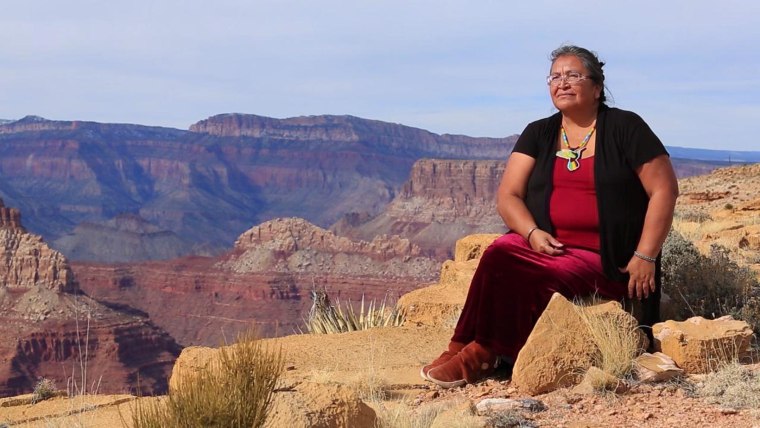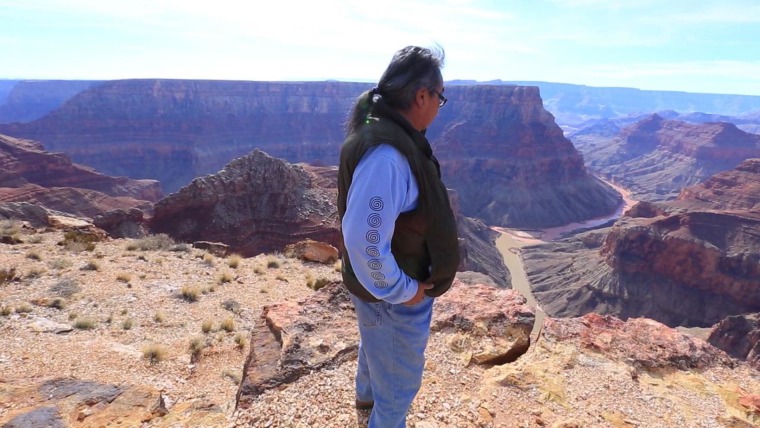As morning light painted the far-reaching buttes of the Grand Canyon gold, Renae Yellowhorse stood at the edge of the canyon's rim, looked out toward where the rivers met below her, and smiled.
"It is my church, it is where I say my prayers. It is where I give my offerings. It's where I commune with the holy ones, the gods that walk along the canyon," said Yellowhorse, a member of the Navajo Nation.
This place, called "the confluence," is where the Colorado River meets the Little Colorado River on the canyon's east side. According to the Navajo creation story, the confluence is where their people first emerged.
And now this Navajo-owned land is at the center of an ugly land-use dispute.
Developers Confluence Partners want to provide the more than 5 million annual visitors to the Grand Canyon National Park with a new 420-acre attraction. Their plans for the canyon's rim include a multimedia complex with an IMAX theater, retail shops, hotels, an RV park and a gondola tram that would take visitors 1.6 miles to the canyon floor in ten minutes. Confluence Partners has also drawn up plans for a "Riverwalk" on the canyon floor that would include elevated connected walkways, a food pavilion, a tramway station, a terraced seating area and a wastewater package plant.

Navajo Nation President Ben Shelly said he plans to green-light the project and the $65 million required from the tribe for road, water and communication facilities.
While overlooking the canyon from its south rim, Shelly explained, "I come here and I look from that view as the President, as the guardian of the Navajo people and our nation ... and say, 'what can I give to my families and my people?'"
Shelly said that the Navajo suffer from unemployment and high suicide rates. "The only conclusion I got from that is that they need jobs, they need homes. They need good homes. They need better education. They need to get involved in a lot and create business," he said.
Business opportunities on this Navajo land are particularly scarce because for 40 years, development on 1.6 million acres of tribal land was halted by the government. The ban, known as "The Bennett Freeze" was intended to prevent both the Hopi and Navajo tribes from building on the land, because the tribes disputed its ownership.
"We are for economic development," said Yellowhorse, whose family still lives and herds cattle on the remote land east of the canyon. "Just not here at this place."
Some members of the Hopi tribe also said that the proposed development is too close to the Hopi Salt Trail, one of their sacred sites. "In many respects, it's a landscape that is really ingrained in our hearts as Hopi people," said Leigh J. Kuwanwisiwma, Director for the Hopi Tribe's Cultural Preservation Office.
Kuwanwisiwma explained that the confluence is the "final spiritual resting place" for his Hopi ancestors, and building a tourist destination "would severely compromise access and our ability to practice religion" on the site.

"Why are they not listening to the Zuni tribes, the Hopi tribes and us, our Navajo people," asked Yellowhorse. "Our medicine men have said this area is a holy place," she said, gesturing to the towering flowers of the yucca plant and gnarled, dense spines of blackbrush that covered the sandy ground.
Albert Hale, a developer from Confluence Partners, who is also Navajo, said the project will allow his tribe to profit from their land while giving visitors to the area a breathtaking view. The tribe stands to make 8 to 18 percent of gross revenue from the development, he said. "The whole intent is to try to get people who otherwise would never be able to experience the Grand Canyon to come and experience that," Hale said.
Shelly is expected to sign a proposed resolution authorizing the project, and developers hope to break ground as early as the spring of 2017, but local tribal members say they will not relent. Leaders like Yellowhorse and Kuwanwisiwma have established a group called "Save the Confluence" and are spreading their message with stickers and painted signs across the Navajo reservation.
"These landscapes and the canyon and the confluence today are still very, very important to the Hopi people and we'll never let that go," said Kuwanwisiwma. "We're not going to give up on being good stewards of these lands. Never."